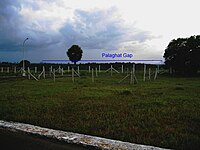|
Geography of Tamil Nadu
Tamil Nadu is the tenth largest state in India and covers an area of 130,058 square kilometres (50,216 sq mi). It is bordered by Kerala to the west, Karnataka to the northwest, Andhra Pradesh to the north, the Bay of Bengal to the east and the Indian Ocean to the south. Cape Comorin (Kanyakumari), the southernmost tip of the Indian Peninsula is located in south of Tamil Nadu. TerrainThe western, southern and north-western parts are hilly and mix of vegetation and arid. Tamil Nadu is the only state in India that has both the Western Ghat and the Eastern Ghat mountain ranges which both meet at the Nilgiri Hills.[1] The Western Ghats dominate the entire western border with Kerala, effectively blocking much of the rain-bearing clouds of the South West Monsoon from entering the state. The eastern parts are fertile coastal plains. The northern parts are a mix of hills and plains. The central and the south-central regions are arid plains.   Natural hazardsTamil Nadu has a coastline of about 1,076 kilometres (700 mi) which is the country's second longest coastline after Gujarat, Tamil Nadu's coastline bore the brunt of the 2004 Indian Ocean tsunami when it hit India, which caused 7,793 direct deaths in the state.[2] Tamil Nadu falls mostly in a region of low seismic hazard with the exception of the western border areas that lie in a low to moderate hazard zone. Parts of this region have seismic activity bagging the M5.0 range.[3] ClimateTamil Nadu is heavily dependent on monsoon rains, and thereby is prone to droughts when the monsoons fail. The climate of the state ranges from wet rainforests to semi-arid plains, with some interior locations bordering on a desert climate. Agriculture in Tamil Nadu is a gamble on the monsoon. The state has distinct periods of rainfall, which are the advancing monsoon period, South-west monsoon (from June to September) with strong southwest winds, the North-east monsoon (from October to December), with dominant northeast winds, and the Dry season (from January to May). The normal annual rainfall of the state is about 945 mm (37.2 in),[4] of which 48% is through the North East monsoon, and 32% through the South West monsoon. Since the state is entirely dependent on rains for recharging its water resources, monsoon failures lead to acute water scarcity and severe drought.[5] See alsoReferences
|
||||||||||||
